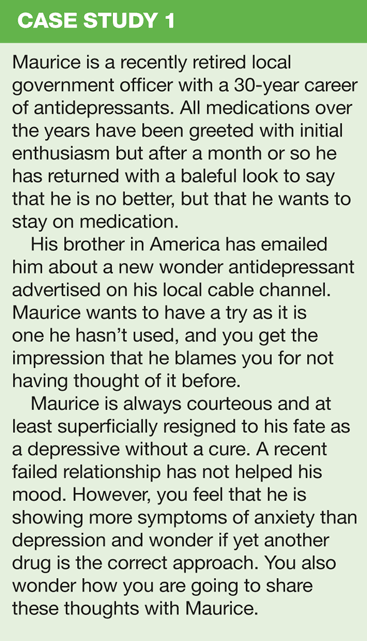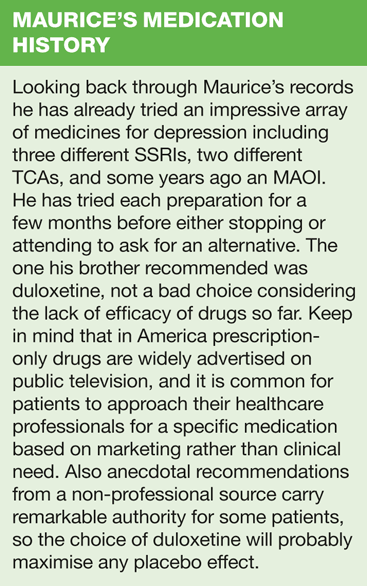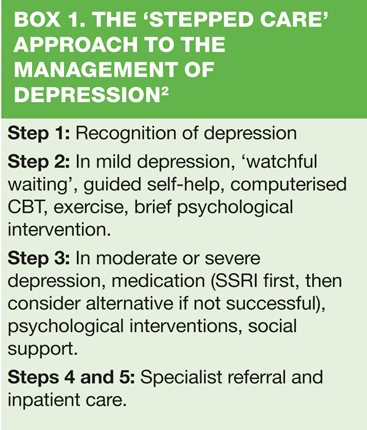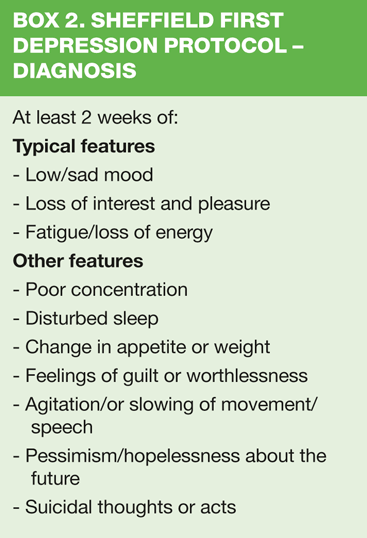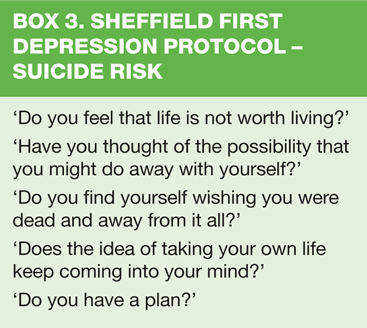Prescribing in depression
Dr Ed Warren
Dr Ed Warren
FRCGP
GP, Sheffield and GP trainer, Barnsley VTS
Depression is a labour-intensive condition to treat in primary care, and patients with depression will often be well-known to practice nurses, who need to be familiar with assessment, treatment options, and how to recognise an emergency presentation
Each year about 6% of people will experience an episode of depression, and 15% will have an episode during their lifetime. Women suffer more so that a quarter of women and a tenth of men will have treatment for depression. Depression is the third commonest reason why people consult a GP, and the commonest psychiatric reason. Depression interacts with other illnesses so that people with physical illness are more likely to be depressed, and depression confers poorer outcomes in a range of physical illnesses including coronary heart disease. Suicide accounts for about 1% of all deaths, and in two thirds of cases this is attributable to depression.1
There is a spectrum in the human experience of lowered mood from the slightly miffed to the sufferer rendered completely immobile by his or her plight. There are definitions to help with diagnosis, notably from the American Psychiatric Association (DSM - IV) and the World Health Association (ICD - 10). However, the ones currently exercising primary care are the questionnaires suggested by the Quality and Outcomes Framework,3 the most popular of which is the PHQ-9. Depression that requires medication is that which is more severe.2
MEDICATION - THE OPTIONS
The NHS Information Centre counts every single prescription dispensed. In England during 2010, nearly 43 million prescriptions for antidepressants were dispensed in the community, at a total cost of over lb220 million.4
All medicines for depression can take several weeks before any effect is seen, and it may be several months before the full effect is apparent. Individual patients vary widely in their susceptibility to both the benefits and side effects of antidepressant drugs. For example, the licensed dose of fluoxetine is from 20mg to 60mg a day, and for amitriptyline 75mg to 200mg a day. It is customary to start on a small dose and then titrate up the dose until either it works or is proved to be ineffective or intolerable. This 'start gently' approach is particularly important in the elderly who generally do not eliminate medication as quickly as younger patients, and who are more likely to have other illnesses and medications with which the antidepressants might interfere.
Selective serotonin reuptake inhibitors (SSRIs)
(23 million prescriptions, £82 million)
For some years now this group of drugs has been the bedrock of prescribing for depression, and SSRIs are the first line drug treatment recommended by NICE.2 Examples include fluoxetine, citalopram and sertraline. The drugs work by artificially boosting brain levels of serotonin, one of the mood neurotransmitters. An SSRI will help in up to two thirds of patients with depression,5 but bear in mind that a placebo effect of up to 30% is found in controlled trials.6 Up to half of patients will not take the medication as prescribed.7 The commonest side effects are gastrointestinal - nausea, vomiting, dyspepsia, abdominal pain, changed bowel action - and tend to be dose-related. Other troublesome side effects are dry mouth, nervousness, sweats and hallucinations. However, side effects are uncommon, and when a patient finds a side effect intolerable it is worth discussing whether they really want to take tablets at all.
Tricyclic antidepressants (TCAs)
(13 million prescriptions, £40 million)
Previously TCAs were used more widely than SSRIs, and are of similar efficacy.5 However, they cause more side effects than SSRIs (some of them severe), and so the chance of stopping treatment is greater.8 They work by inhibiting the uptake of noradrenaline, another mood neurotransmitter, and sometimes serotonin as well.9 Examples include imipramine and amitriptyline. Antimuscarinic side effects - dry mouth, blurred vision - are quite common and are dose-related so that they often limit the dose that can be tolerated. Other side effects include drowsiness and heart rhythm irregularities, which should be particularly looked out for in the elderly.
Monoamine oxidase inhibitors (MAOIs)
(57,000 prescriptions, £2 million)
MAOIs are another group of antidepressants that have fallen from favour because of a poor side effect profile. They cannot be taken with other antidepressants, and patients who take them should avoid foods with tyramine (e.g. 'Oxo', 'Marmite') lest their blood pressure rise dramatically and dangerously. Lists of foods to avoid are found in the patient insert leaflets.
Other antidepressants
(7 million prescriptions, £95 million)
This is a group of unrelated drugs that just happen to boost levels of serotonin, noradrenaline, or both. Examples include duloxetine and mirtazepine, mirtazepine being the one that finds most favour with NICE.2 It will be seen that as a group they are significantly more expensive that SSRIs - a third the number of prescriptions have cost more in total.
ALTERNATIVES TO DRUG THERAPY
None of the available guidelines suggest that drugs alone are sufficient treatment for depression of any severity. For mild to moderate depression (loosely equating to a PHQ-9 score of under 15) NICE suggests that drugs should not be used at all, except where a patient has needed drugs in the past; where symptoms have persisted for more than 2 years; or where there has been a failure of other treatments.2
Suggested general measures include:
- Sleep hygiene, for example the excellent patient pamphlet produced by NHS Northumberland at http://www.ntw.nhs.uk/pic/leaflets/Sleeping%20Problems%20A4%202010.pdf
- Active monitoring - to see if the symptoms will correct themselves
- Physical activity programme. Increasing exercise is of proven benefit in all severities of depression, and works rather more quickly than medication10.
- Cognitive behavioural therapy (CBT), including behavioural activation and problem-solving techniques, either face-to-face, by telephone, or on the Internet. This treatment requires repeated sessions over several weeks, and so is labour-intensive from a therapist perspective and also requires considerable commitment from the patient of whom up to 40% will drop out from treatment.10
Where the depression is more severe, a range of more intensive psychological interventions is recommended in addition to medication. These would include personalised face-to-face CBT or Interpersonal Therapy (IPT). This is clearly more than traditional primary care can deliver, which has led to the development of the Improving Access to Psychological Therapies (IAPT) programme in the NHS, which has placed mental health workers (including those who can do CBT) in many surgeries.
GUIDELINES
A Google search for 'Depression Guidelines' garners 41.5 million hits. Whatever else the problems of the depressed and their carers, they do not suffer from a lack of advice.
Probably the most widely used guidance in the NHS is that issued by the National Institute for Health and Clinical Excellence, the latest having been published in 2009.2 The guidance is summarised in box 1.
The Quality and Outcomes Framework requirements also suggest guidance on the management of depression, and this will particularly exercise workers in primary care. A total of 31 points are on offer, but the main emphasis is on the detection of depression in patients who have other chronic diseases, and the assessment of the severity of depression. No guidance is offered about treatments.
ASSESSMENT AND REVIEW
Depression is not all that common, but cases tend to need a lot of work in terms of assessment and follow-up. In 10% of cases the depression is persistent, and the risk of further depressive episodes is 50% after one episode, 70% after 2 episodes and 90% after 3 episodes.1 Also, depression often presents as an emergency because sufferers will get to the end of their tether before contacting their healthcare advisors. Accordingly, practice patients with depression will often be well-known to practice nurses who are involved in triage work.
In recurrent depression, making the diagnosis is often not a problem - this is an action replay of previous events. If this is a first episode, the diagnosis can be made with reference to one of the sets of diagnostic criteria that are available. My local health authority publishes a usefully brief list of symptoms to look for - see box 2.
If there is any doubt about the diagnosis then getting your patient to fill out a PHQ-9 can be helpful. A score of 10 or more is 88% sensitive and 88% specific for major depression.12
A major complication of depression is suicide. Assessment of suicidal risk should figure in all first assessments of depression, and in all early subsequent assessments until the risk has abated. There are some useful questions to ask. (Box 3) Asking the questions does not make suicide any more likely11 - a potentially suicidal patient will have thought of all these things long before coming to see you.
A first consultation with a patient with depression will tend to be prolonged, and cannot be cut short. If suicide risk is high then your patient may need regular review over the first few days, and an actively suicidal patient may need hospital admission. Where risk is low a review after 2 weeks is appropriate, to review symptoms and to see if any medication is being tolerated. Once progress is being achieved the review intervals can be extended. Any medication should be taken for at least 6 months after symptoms have resolved to reduce the chance of a relapse.2
PITFALLS AND DANGERS
The main danger is suicide or attempted suicide. This is particularly upsetting if the method used is an overdose of prescribed medication. Every patient with depression should have their suicide risk assessed using a reliable assessment tool at least once.
Guilt and worthlessness are features of depression, which makes some people with depression refuse treatment. Expressing depression as a deficiency disease for specific neurotransmitters sometimes helps.
In all severities of depression, psychological interventions are advised. Providers of these interventions are still scarce given the magnitude of the problem, and certainly cannot be accessed with the desired speed. Psychological interventions require patients to do a lot of talking and homework - many are unable to do this, especially when feeling mentally lethargic because of their depression.
Some people do not like taking tablets whatever the reason. Some people who take antidepressant drugs get significant side effects so that, at least at first, they feel a lot worse.
REFERENCES
1.Benninger M., Segreti J (2008) Is it bacterial or viral? Crit1. Clinical Knowledge Summaries. Depression. Available at: http://www.cks.nhs.uk/depression
2. NICE Clinical Guidelines 90&91. Depression http://www.nice.org.uk/nicemedia/live/12329/45890/45890.pdf
3. QOF guidance for GMS contract 2011/12. http://www.nhsemployers.org/SiteCollectionDocuments/QOFguidanceGMScontract_2011_12_FL%2013042011.pdf
4. NHS Information Centre. Prescribing Cost Analysis for England 2010. http://www.ic.nhs.uk/webfiles/publications/007_Primary_Care/Prescribing/Prescription_Cost_Analysis_England_2010/Prescription_Cost_Analysis_2010.pdf
5. Hirschfeld RM. Efficacy of SSRIs and newer antidepressants in severe depression: comparison with TCAs. J Clin Psychiatry. 1999 May;60(5):326-35. http://www.ncbi.nlm.nih.gov/pubmed/10362442
6. Spigset O and Martensson B. Drug treatment of depression. BMJ 1999;318:1188-91.
7. Hale A S. Depression. BMJ 1997;315:43-6.
8. British National Formulary 61. http://bnf.org
9. P K Gillman. Tricyclic antidepressant pharmacology and therapeutic drug interactions updated. Br J Pharmacol. 2007 July; 151(6): 737-748.
http://www.ncbi.nlm.nih.gov/pmc/articles/PMC2014120/
10. Smeaton J. Physical exercise and mental health. Psychiatry in Practice. 1995;14(3):16-18
11. Coates T. Suicide. GP October 13 1995:55-8.
12. Kroenke K, Spitzer RL, Williams JB. The PHQ-9: validity of a brief depression severity measure. J Gen Intern Med. 2001 Sep;16(9):606-13.
http://www.ncbi.nlm.nih.gov/pubmed/11556941?dopt=Abstract
5.The Merck Manuals Online Medical Library Antibiotics. 2008 http://www.merckmanuals.com/home/sec17/ch192/ch192a.html
6.British National Formulary 2011 http://bnf.org/bnf/index.htm
7.Health Protection Agency (2011) Clostridium Difficile http://www.hpa.org.uk/Topics/InfectiousDiseases/InfectionsAZ/ClostridiumDifficile/
8.Surawicz C. Antibiotics and Clostridium difficile: Cause and Cure. J Clin Gastroenterol 2007;41:1-2
9.Mcfarland L. Alternative treatments for Clostridium difficile disease: what really works? J Med Microbiol 2005;54:101-111.
10.Centre for Medical Consumers. Bibliography for: Overuse of antibiotics causing severe illness and fatalities in U.S. and Canada. 2006 http://findarticles.com/p/articles/mi_m0815/is_1_31/ai_n26721744
11.World Health Organization Antimicrobial resistance. 2011;Fact sheet 194. http://www.who.int/mediacentre/factsheets/fs194/en/index.html
12.Centers for disease Control and Prevention. Get smart: Know when antibiotics work. 2010 http://www.cdc.gov/getsmart/antibiotic-use/anitbiotic-resistance-faqs.html
13.Styers D, Sheehan DJ, Hogan P, et al (2006) . Laboratory-based surveillance of current antimicrobial resistance patterns and trends among Staphylococcus aureus: 2005 status in the United States. Ann Clin Microbiol Antimicrob 2006; 5:2.
Related articles
View all Articles
